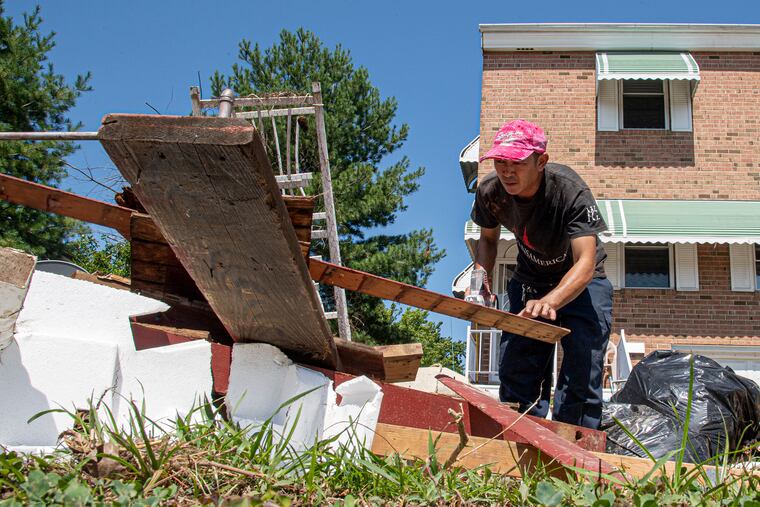A spring maintenance checklist for protecting your home
Homeowners are increasingly concerned about extreme weather, which can happen sporadically in the spring. A home insurance company shares maintenance tips for homeowners to protect themselves.

Temperatures are getting warmer, and the official start of spring is around the corner. For homeowners, it’s a time for sprucing up.
But spring cleaning can be more than a reason for a household to tidy up. It could protect a home from serious — and expensive — issues down the line. It can make a home safer. And since spring is a popular time for owners to list their homes for sale, now is when those potential sellers need to make sure their properties are in order.
Homeowners are increasingly concerned about extreme weather and the effects of climate change, said Courtney Klosterman, a home insights expert at the home insurance group Hippo. And in the spring, “we tend to get a lot of that sporadic extreme weather,” such as high winds and excess rain.
» READ MORE: Home insurance is getting more expensive. Extreme weather and rising home costs help explain why.
Homeowners can help protect themselves and their properties by keeping up with their home maintenance.
“One of the best things to do for any homeowner, especially if you’re not sure where to start, is to just build a maintenance checklist that starts with the exterior of your home,” Klosterman said. That’s where owners are likely to see weather-related damage and where repairs tend to cost the most.
More frequent extreme weather also is largely to blame for the rising cost of home insurance. Homeowners might qualify for discounts with their insurers if they take steps to maintain and protect their homes, such as upgrading roofing materials or adding a security system, she said.
Klosterman also said homeowners should make sure they know what their insurance policies cover and consider whether they need additional coverage based on local conditions and potential hazards. Insurance agents can walk homeowners through their policies.
As spring approaches, Klosterman shared some maintenance tips for homeowners.
» READ MORE: How Philadelphia-area homeowners can save money on insurance
Inspect the outside of your house for wear and tear
Walk around your property and stare at your house. Look at your roof, gutters, and siding or walls for signs of deterioration. “These areas are gonna be the most common for experiencing wear and tear, especially coming out of the winter,” Klosterman said.
Is the roof missing shingles? Do you see dark streaks, which could be signs of algae or moss? Is anything sagging, leaking, or warped? Are there holes in the siding where pests could get in? Do you see cracks or peeling paint on exterior walls? Are gutters and downspouts clear and directing water away from your house?
» READ MORE: Leaks, termites, and cracked foundations: Skipping home inspections in a competitive market is tempting — and risky
“The best and easiest way for you to get started is just doing that visual inspection,” Klosterman said. That look around can catch little problems before they become big ones and protect the structural integrity of the house. Cracks in the driveway, for example, may lead to or be signs of larger structural issues.
Klosterman recommends borrowing or buying a pressure washer and cleaning the home’s exterior, including siding, doors, and windows. Taking that step can remove pests that made the outside of your home their home during the winter months and remove debris, as well as making the outside of the home look nicer and making elements of the home last longer.
Deep clean for safety
Carefully cleaning inside your home can help you spot damage or potential problems you wouldn’t usually see. Check and clean hard-to-reach areas such as vents and ceiling fans.
Decluttering can make your home safer by reducing fire hazards and clearing pathways to exits in an emergency.
Cleaning and sealing floors can keep moisture out and make them last longer.
Inspect and clean windows and doors to help weatherproof your home. Look for tears in screens and broken seals, and consider installing storm doors.
Prevent property damage with landscaping
Maintaining a yard not only makes a home look nice, but it also can prevent storm damage. Make sure trees are sturdy and upright, and trim branches that hang close to your home, so they don’t fall or let streams of water flow onto it.
Water damage is common and expensive. Make sure that your yard drains well and that irrigation systems aren’t hitting your home or the sidewalk.
» READ MORE: FEMA’s new insurance system aims to make premiums fairer as climate change raises flooding risks
Beware basements
Speaking of flooding, if you have a basement, check for signs of water damage in the walls, floor, and among your belongings. Is there a musty smell? Do you see cracks, mold, or water stains?
Changing temperatures from winter to spring can mean new or growing cracks in your basement that can let water in.
Clean your sump pump’s pit and pieces, and test that everything works by filling the pit with water and making sure it drains. And make sure your basement has good ventilation.
Problems in the basement can be signs of problems with your foundation or plumbing.